Teach close reading skills, ekphrastic poetry, and humanity with Picasso’s Guernica
Picasso’s Guernica is in the collection of the Museo Nacional Centro de Arte. See their website for detailed information. Click on the painting for a high quality image that can be magnified.
Guernica, the most ancient town of the Basques and the centre of their cultural tradition, was completely destroyed yesterday afternoon by insurgent air raiders.… The object of the bombardment was seemingly the demoralization of the civil population and the destruction of the cradle of the Basque race. Every fact bears out this appreciation, beginning with the day when the deed was done. Monday was the customary market day in Guernica for the country round. At 4:30 pm, when the market was full and peasants were still coming in, the church bell rang the alarm for approaching aeroplanes…The tactics of the bombers, which may be of interest to students of the new military science, were as follows: First, small parties of aeroplanes threw heavy bombs and hand grenades all over the town, choosing area after area in orderly fashion. Next came fighting machines which swooped low to machine-gun those who ran in panic from dugouts, some of which had already been penetrated by 1,000 lb bombs, which make a hole 25ft. deep. Many of these people were killed as they ran. A large herd of sheep being brought in to the market was also wiped out. The object of this move was apparently to drive the population under ground again, for next as many as 12 bombers appeared at a time dropping heavy and incendiary bombs upon the ruins. The rhythm of this bombing of an open town was, therefore, a logical one: first, hand grenades and heavy bombs to stampede the population, then machine-gunning to drive them below, next heavy and incendiary bombs to wreck the houses and burn them on top of their victims. The only counter-measures the Basques could employ, for they do not possess sufficient aeroplanes to face the insurgent fleet, were those provided by the heroism of the Basque clergy. These blessed and prayed for the kneeling crowds—Socialists, Anarchists, and Communists, as well as the declared faithful – in the crumbling dugouts.
—George Steer’s eyewitness account of the bombing of Guernica inspired Picasso to record the atrocity in his mural Guernica. You can access the full text at this site without paying a subscription fee. Steer biographer, Nicholas Rankin, reads the account with video footage of the bombing.
Look at Picasso’s Guernica. Before reading the excerpt above, tell students the title and ask what is going on in this picture? There are a lot of imagery here to unpack and the cubist approach may initially be a little disorienting. See how much students can decipher through a discussion. Encourage students to identify the evidence that supports their reasoning. Students should likewise be encouraged to share wonderings and voice confusions. As the conversation slows, explain you are going to read an eyewitness news account that inspired this painting. After reading the excerpt ask how does this new insight change your understanding of the painting?
Begin with art history
Pablo Picasso created Guernica to bring worldwide attention to the bombing of the defenseless city of Guernica by the German air force during the Spanish Civil War. The city of Guernica in northern Spain was a stronghold of the Republican forces that supported the democratically elected, leftist government. (Do not confuse with the Republican party in the United States.) In coordination with the conservative Nationalist forces led by General Francisco Franco, Hitler’s German warplanes methodically bombed the city and its civilian population for more than two hours. At the time of the bombing, the city was mostly populated with women and children, since the men were off fighting. While there were initial attempts to cover up the atrocities, it has since been established that the German military used Guernica as a training ground for the saturated bombing tactics they would pursue during World War II.
In 1937 Paris prepared to host a World’s Fair dedicated to advances in art and technology. Early on, Spain’s Republican government commissioned Picasso to create a mural for their pavilion. The bombing of Guernica occurred a month before the opening and redirected Picasso’s efforts.
Guernica is recognized as a revolutionary work of art for its innovative approach to cubism and to history painting. Picasso’s prior Cubist painting had been formal, academic studies where he had analytically broken up and reassembled his subjects to show them from multiple angles all at once. These geometric abstractions were cool and aloof. Guernica’s emotional plea for humanity changed all that. Guernica also transformed the history painting genre. While depicting a moment in history on an epic scale, Guernica did not pursue a realistic likeness, and it most certainly did not try to depict the heroic soldier engaged in glorious battle. Picasso used the fractured vocabulary and viewpoint of Cubism to fittingly render the horrors and destruction of war. He infused Cubism with a conscience and created a new kind of modernist history painting.
Look like an art critic
This image from the Museo Nacional Centro de Arte offers exquisite detail. Thank you Museo Nacional Centro de Arte! Look at Guernica. What do you notice? This is a particularly complex painting so you may want to make this a whole-class discussion and record answers on an anchor chart. (Possible answers: There is a large bull in the upper-left corner standing above a woman who cries in anguish as she holds her dead child. A soldier lies dead on the ground, his body as broken as his sword. In the center a horse, pierced by a spike, begins to collapse, a large wound in his side. An electric light burns above its head. A woman leans out a window holding a lantern lit by a flame. Another woman with a distorted leg gazes at the lantern as she lurches through a door. A third woman with her hands raised, screams in horror as flames erupt around her. There are two images you may need to highlight. One is the flower growing near the soldier’s hand holding the sword. The other is the bird almost lost in the shadows between the bull and the horse’s head. Note, there are also subliminal or hidden images that your students may notice, but it may be a distraction to point them out if they go unrealized. There is a profile of a skull in the center of the painting. The back of the skull is on the left, the bent leg of the horse forms the lower jaw of the open mouth. The horse’s lower leg also makes up a bull’s snout, his horn gores the horse’s belly. There is also clearly shown an arrow that most people overlook. This video can help you show these but, again, if you are looking for a simple introduction to Guernica, this may be more of a distraction, than an instructional benefit.)
The Monochromatic Color Scheme
Point out and discuss: Note that that this mural is rendered completely in a monochromatic grey scale. During his career Picasso had oftentimes created paintings with a limited palette. See his Blue Period or his Rose Period. As he sketched Guernica, Picasso experimented with the strategic use of other colors. For example, at one point the wailing mother cried a blood-red tear. In other places he had included scraps of wallpaper as he had done in early collages. In the end, he did away with all of these colors. What does the monochromatic color scheme make you think of and how does it serve the painting?
Turn, Talk, and Report Back (Possible answers: Black and white makes me think of newsprint or an old photograph. So it seems more factual and objective. It also has the ripped-from-the-headlines feel. It reminds the viewer this is real. Sometimes color can be emotional and sensual. There is nothing warm or pleasant here. The lack of color makes it more stark and brutal, like war. If he had included a blood-red tear that would have been too prominent, distracting from the rest of the painting. Without the distraction of color, the lines and shapes take on more importance. The viewer is forced to take in the whole painting and look deep into the shadows. The diagonal patterns of the lights and darks slash across the canvas. This visual tearing underscores the violence of the scene. The black and white color scheme could be a metaphor for good and evil. It makes the shadows darker and more ominous and the light from the lantern brighter and more hopeful. All the blacks make me think of a funeral, so it is more somber)
Scale
Point out and discuss: It is important to remember when you look at images of Guernica, that they are a fraction of the size of the original. The original painting is more than 11 feet high and more than 25 feet across. (Mark this off on the wall so students can better appreciate the scale of the mural.) How do you think your perception of the painting changes if you stood before the original and how does this monumental size serve the painting?
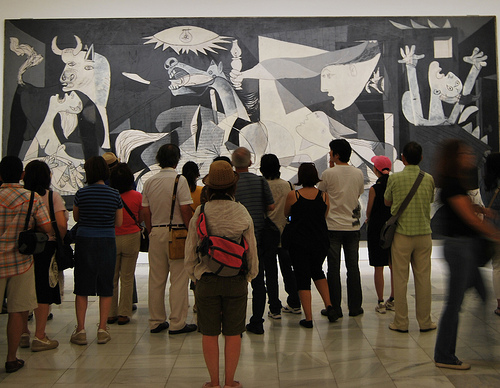 Turn, Talk, and Report Back (Possible answers: The size is overwhelming. It actually towers over you and fills your line of vision to the right and the left. This makes the scene of destruction even more overwhelming. The victims of the bombing are bigger than life size. That makes me think of them as more human and me as part of the scene. At that size it seems more lifelike and that it could happen to you. When the canvas is that big it is like the artist is screaming, “Look at what they did.” At that size it is harder to look away.)
Turn, Talk, and Report Back (Possible answers: The size is overwhelming. It actually towers over you and fills your line of vision to the right and the left. This makes the scene of destruction even more overwhelming. The victims of the bombing are bigger than life size. That makes me think of them as more human and me as part of the scene. At that size it seems more lifelike and that it could happen to you. When the canvas is that big it is like the artist is screaming, “Look at what they did.” At that size it is harder to look away.)
Symbolism and Ambiguity
Point out and discuss: Picasso incorporated a lot of symbols in Guernica, but he did not define them. Instead, he explained,
It isn’t up to the painter to define the symbols. Otherwise it would be better if he wrote them out in so many words! The public who look at the picture must interpret the symbols as they understand them.
Some interpretations are clearly intended and universally understood, others are so complex and layered, they could carry multiple meanings. For example the two sources of light, the lantern and the electric light, are placed next to each other in obvious contrast. The electric light shaped like a human eye, has been described by some as the evil eye, the anonymous eye of the interrogator or the bombardier looking down on its victims. Its rays of light are ominous with sharp exploding edges. In contrast, the lantern light is brought forth by one of the victims and, while small, it illuminates the world and attracts the wounded woman. To further support this reading some have pointed out that “light bulb” in Spanish is ‘bombilla,’ and ‘bomba’ means ‘bomb.’ They contend that this play on words is a poetic metaphor for the terrifying power of technology. It is also interesting to note the lack of certain imagery and symbols, such as historical references that tie the bombing to a specific time and place. How do the symbols and their multiple readings serve the painting?
Turn, Talk, and Report Back (Possible interpretations: The lack of history-specific imagery makes the reading of the painting more universal and timeless. The ambiguity of the symbols compels the viewer to make their own interpretations. This added investment makes the experience more memorable to the viewer. The added layers of meaning allows for a deeper more personal understanding of the piece. The ambiguity encourages discussion, which makes the painting a catalyst for sharing ideas about the injustices of war. )
Think like an artist
From 1939-1952 Guernica was exhibited throughout the United States to raise awareness and funds for Spanish refugees. It has since become a potent anti-war symbol and been used to remind the world about the terrible toll military conflicts have on innocent civilian populations. These images show how Guernica’s imagery has been used to protest the Vietnam War and the war in Iraq.
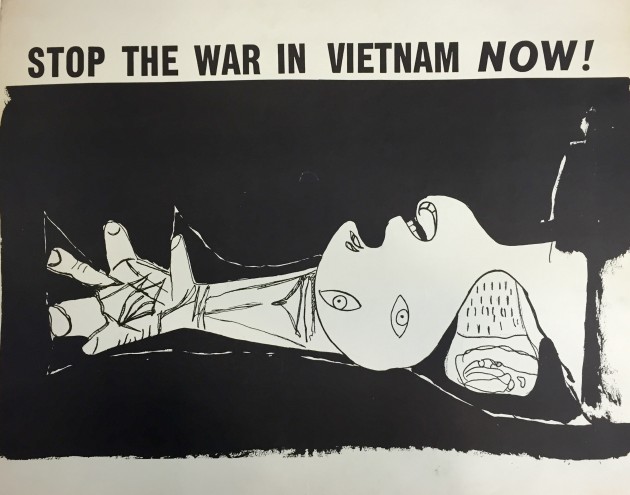
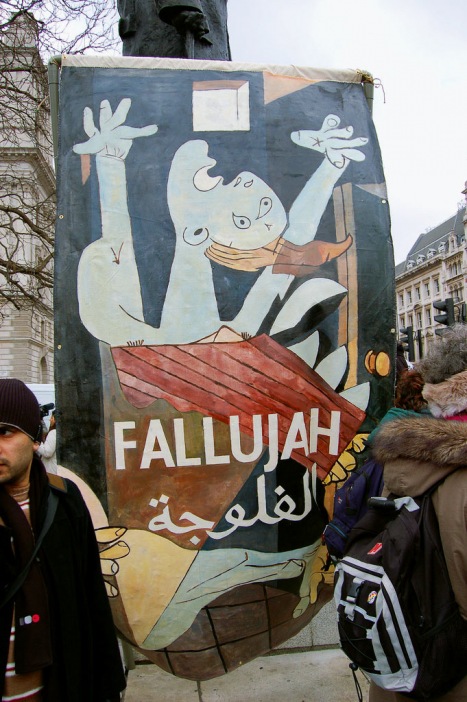

More recently, Guernica ‘s imagery has been used to highlight institutional injustices that threaten a society’s most vulnerable. For example, Keiskamma after Guernica is a tapestry woven by a women’s cooperative in Cape Town that confronts the injustices in the health care system and the impact of AIDS on women and children in South Africa.
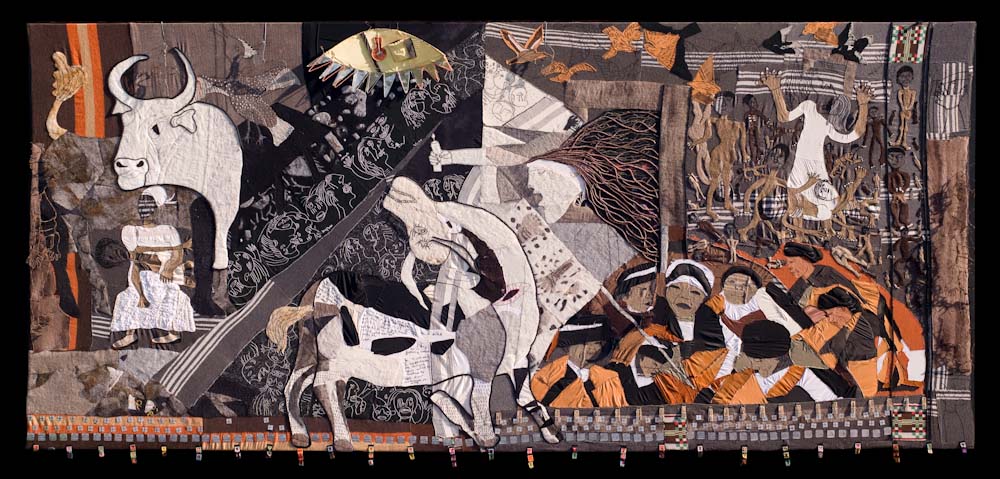
Jovcho Savov’s Aegean Guernica uses Picasso’s imagery to highlight the plight of the Syrian refugees as they flee their war-torn country in overcrowded boats and try to enter Europe through Greece.
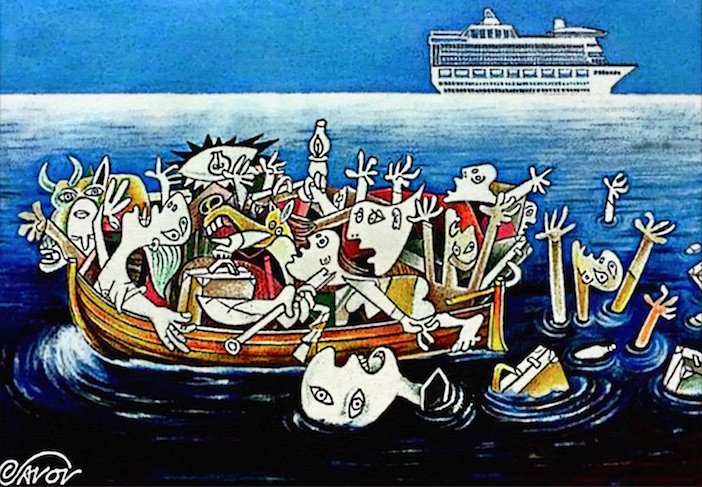
Ron English, an artist who has done over 50 Guernica studies, reacts to the cultural bias that has built up around the painting and how its widespread use undermines the painting’s original power. He contends that while Guernica depicts the horrors of modern war, the cultural takeaway of Guernica is actually the opposite.
It transforms incomprehensible tragedy into a cartoon narrative, something we can more easily absorb… My Guernicas call attention to the product placement of global corporate culture, using war as entertainment and entertainment as war.

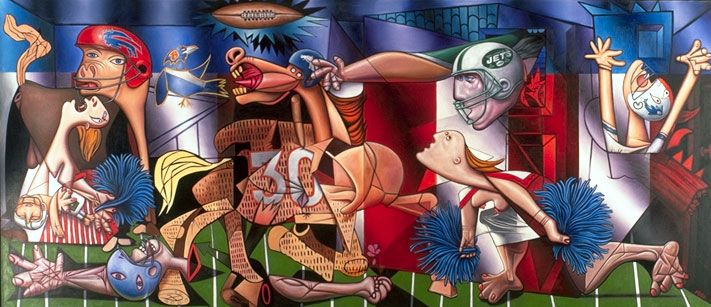
Do you agree with Ron English? Has the widespread use of Guernica’s imagery desensitized the viewer, or do you think it remains a potent symbol of senseless violence and injustice? How would you adapt Guernica or use its imagery to draw attention to the “conflicts” and “refugees” in your world?
Life Lesson
Write what you want to read and make the art you want to see. Guernica is a giant painting with a very intricate composition that required multiple large-scale drafts. Yet, Picasso completed it in less than a month. In addition, he created a new approach to history painting and adapted his own approach to Cubism. Guernica was a massive undertaking, done with a limited amount of time, and executed with tremendous innovation. So how did Picasso do it? Picasso had read George Steer’s account and clearly felt he had something to add. With urgency and passion as his guide, he “rewrote” the account the way he wanted to see it expressed. Don’t wait on others. Make the art that inspires you.
Related video
- BBC Power of Art: Picasso Guernica (10:33) vividly describes the bombing of Guernica and describes how cubism with a conscious creates a modern history painting
- Art History Online’s Pablo Picasso—Guernica (20:14) analyzes the use of geometrical shapes in the composition
- Spencer’s Painting of the Week: Guernica (Picasso)(7:23) 0ffers various interpretations of the mural’s symbols
Integrating into Your Curriculum
Artists oftentimes use common visual strategies or signposts to alert viewers to significant details in their art. Here are some ideas for using these visual signposts to unpack a work of art. Remember, the close reading skills in art appreciation are similar to the close reading practices taught in reading.
Literature Link: What piece of literature would you partner with Guernica?
- Enrich Maria Remarque’s All Quiet on the Western Front vividly depicts the trauma of trench warfare during World War I through the eyes of a German soldier.
- Ernest Hemingway’s For Whom the Bell Tolls tells the story of an American fighting for the Republican cause during the Spanish Civil War.
Writing opportunity: ekphrastic poetry. In addition to inspiring visual artists and activists, Picasso’s Guernica has also inspired ekphrastic poetry, the strategy of using words to describe or respond to a work of art. This can be a wonderfully expressive approach to writing that can quickly get students beyond the initial writing block—What do I write about? Have students write their own ekphastic poem or rap about this painting that ties this bombing to current conflicts. This can be done as a small-group or whole-class project with students brainstorming descriptive phrases. Here are some Guernica-based ekphrastic poems that you can use to introduce the assignment and model the technique.
- Lou Barrett’s Again Guernica
- Jeffrey Lilly’s Guernica (video, 1:20)
- Ruthven Todd’s The Drawings for Guernica
How would you use this painting to elaborate on one of your units of study? Please share if you have other ideas on how to teach Picasso’s Guernica as an English/language arts lesson plan.


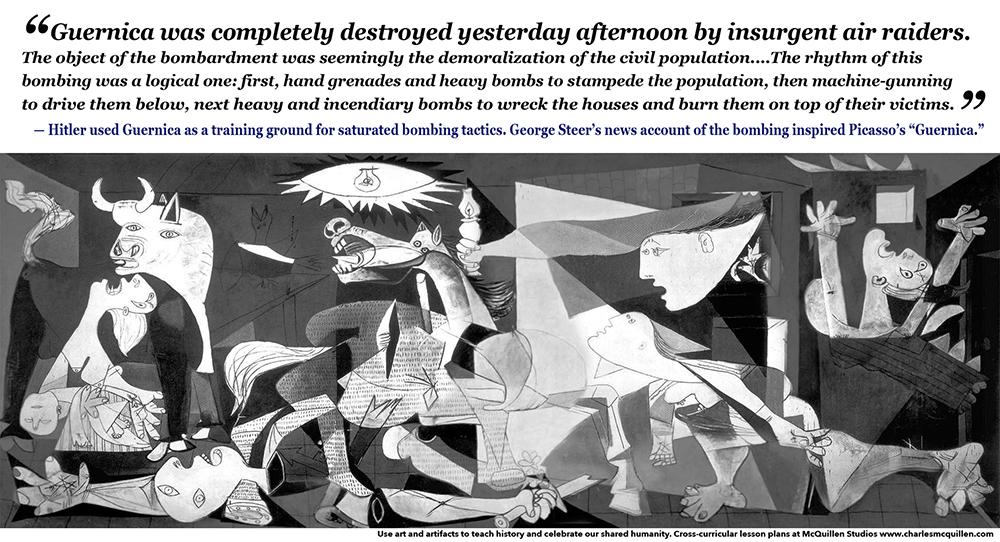
Comments are closed, but trackbacks and pingbacks are open.